Overview
Starter gym equipment encompasses essential tools like dumbbells, resistance bands, yoga mats, kettlebells, and jump ropes, which are crucial for beginners embarking on their fitness journeys. The article highlights that these items facilitate a variety of exercises, improving strength, flexibility, and cardiovascular health, thereby making them indispensable for those new to fitness and aiming to create effective workout routines.
Introduction
Embarking on a fitness journey is not just about the physical transformation; it’s a powerful commitment to overall well-being and personal growth. For beginners, having the right tools and knowledge can make all the difference in achieving lasting success.
From selecting essential gym equipment that enhances workouts to understanding how to use that equipment safely, the foundation of a rewarding fitness experience starts here. This article explores key elements that will empower newcomers to:
- Create balanced routines
- Set realistic goals
- Find the motivation needed to thrive
With the right guidance and support, anyone can unlock their potential and embrace a healthier lifestyle, paving the way for a journey filled with achievement and fulfillment.
Essential Starter Equipment for Beginners
Embarking on a wellness journey is an empowering step, and equipping yourself with the right tools is crucial for success, especially for beginners. Here’s a selection of essential starter gym equipment that can enhance your exercise experience:
- Dumbbells: These versatile weights are ideal for a range of strength training exercises, allowing beginners to target various muscle groups effectively. Their adaptability makes them a staple in any fitness regimen.
- Resistance Bands: Ideal for improving strength and flexibility, resistance bands are portable, making them easy to incorporate into any exercise regimen. They offer a unique way to build muscle without the bulk of traditional weights.
- Yoga Mat: A yoga mat is essential for floor exercises and stretching routines. It offers comfort and stability, ensuring safety during exercises, especially for those new to fitness.
- Kettlebells: Known for their dynamic design, kettlebells are excellent for full-body exercises. They improve strength, endurance, and flexibility, making them a fantastic addition to any beginner’s toolkit.
- Jump Rope: This budget-friendly piece of cardio equipment is not only effective for enhancing cardiovascular health but also improves coordination and agility, which are essential for overall well-being.
Equipping yourself with this starter gym equipment will significantly elevate your exercise experience, helping you stay motivated and focused on your wellness objectives. The right starter gym equipment can be a game-changer on your journey to improved health and performance, particularly as trends suggest a continued increase in home exercise solutions. In 2020, individuals aged 26-35 accounted for 33.8% of the home exercise equipment market, reflecting a shift towards accessible and convenient workout options.
Additionally, the pandemic saw 16% of adults in the United States starting to use more online exercise videos, emphasizing the importance of beginner-friendly equipment in adapting to this new landscape. Investing in the right tools now ensures that you’re prepared for a successful wellness journey ahead. As mentioned in the case study 'Conclusion on Home Wellness Industry Trends,' the home exercise sector has transformed significantly, with a growing demand for solutions that offer convenience and affordability.
Significantly, Nike reported a total revenue of approximately $44.5 billion in its fiscal year 2022, highlighting the wellness market's growth and the increasing demand for home exercise solutions.
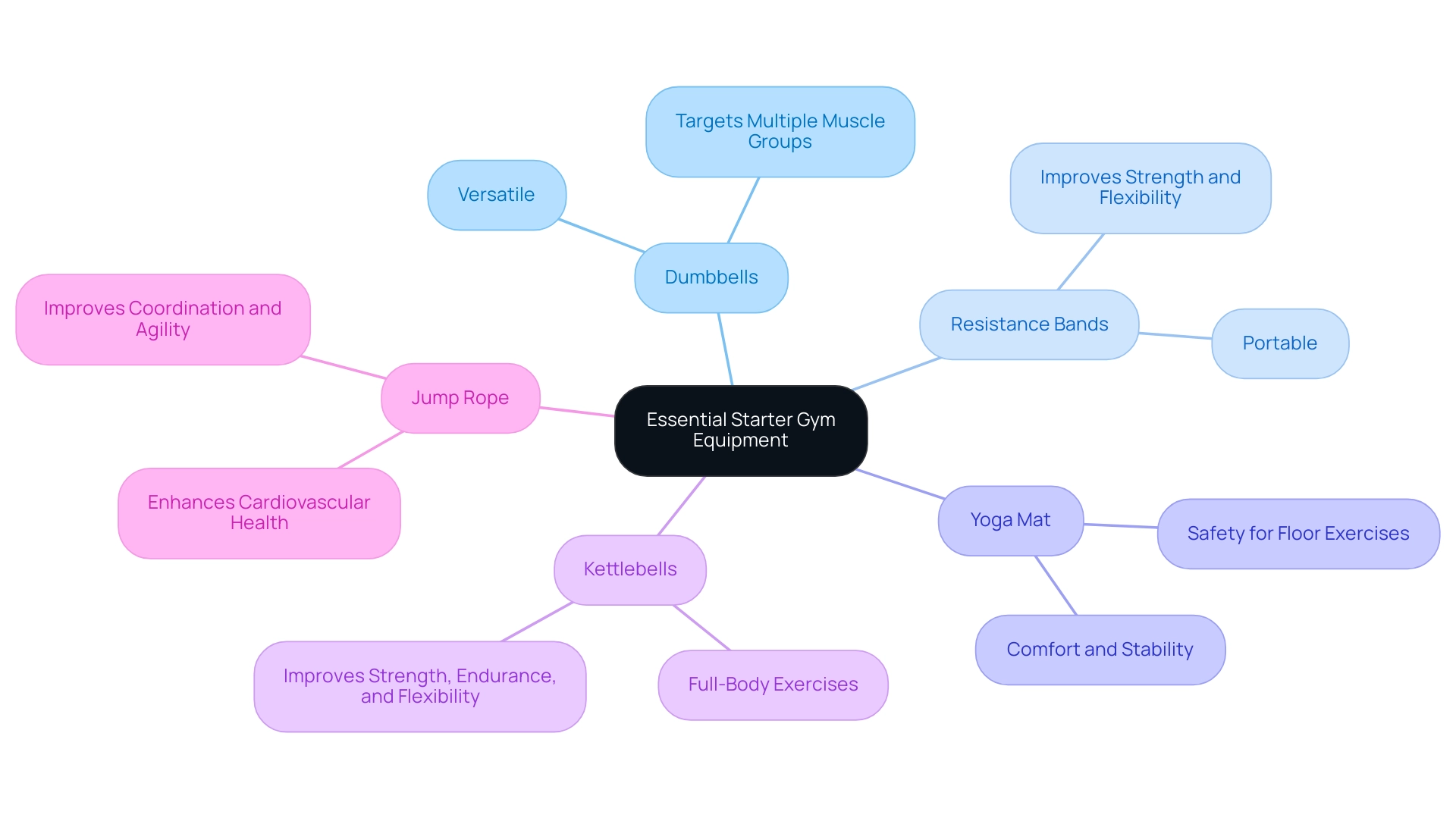
How to Use Gym Equipment Safely and Effectively
Using starter gym equipment safely and effectively is paramount for beginners, as it not only helps to avert injuries but also paves the way for achieving fitness goals. Here are essential tips to foster a safe workout environment:
- Start with the Basics: Begin by familiarizing yourself with each piece of equipment before diving into your exercise. Most gyms provide orientations or have knowledgeable staff available to assist you in understanding usage.
- Read Instructions: Always take a moment to read the instructions or guidelines posted on machines. Understanding how to adjust settings and properly use the equipment is crucial for your safety and effectiveness.
- Maintain Proper Form: Prioritize your form over lifting heavier weights. Proper alignment and technique are vital for preventing injuries. Seeking feedback from a trainer can significantly enhance your form and boost your confidence.
- Warm-Up and Cool Down: A proper warm-up before your exercise prepares your muscles and joints for the activity ahead, while cooling down afterward helps mitigate muscle soreness and supports recovery.
- Listen to Your Body: Tune into how your body reacts during workouts. If you experience pain or discomfort, it’s crucial to stop the activity and reevaluate your technique or seek advice from a health expert.
By following these guidelines, beginners can confidently interact with starter gym equipment, fostering a more enjoyable and effective exercise experience. Remember, as Dr. Graves emphasizes, "It is critical that manufacturers, retailers, owners, users, and healthcare providers prioritize safety as a component of a healthy lifestyle." This method not only fosters a positive relationship with physical activity but also encourages long-term health and well-being.
With the global digital wellness market projected to reach $59.231 billion by 2027, the exercise landscape is evolving; ensuring safety and proper form will be key to thriving in this dynamic environment. Additionally, a recent case study titled "Diagnosis and Discharge Disposition of Exercise Equipment Injuries" highlighted that most injuries related to mechanical home exercise equipment are soft tissue injuries, underscoring the necessity for safety measures. By prioritizing safety, we can help prevent the types of injuries detailed in this study and support a healthier exercise experience for all.
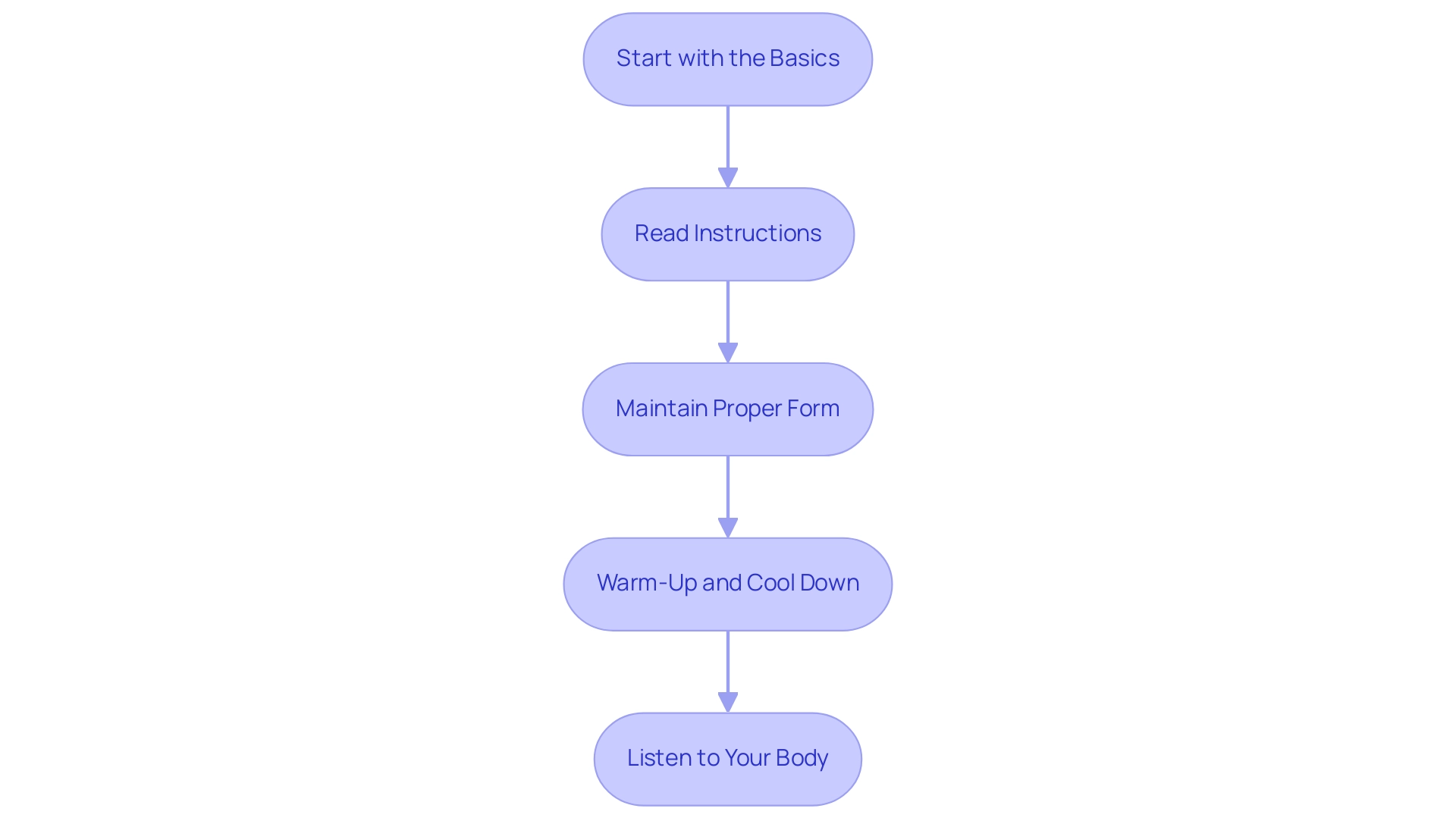
Creating a Balanced Workout Routine
Creating a balanced workout routine using starter gym equipment is essential for fostering comprehensive fitness and supporting overall well-being, particularly in workplace settings. Here’s how you can effectively structure your routine:
-
Strength Training: Incorporate starter gym equipment for strength training activities at least two to three times a week.
Utilizing starter gym equipment like free weights, resistance bands, or bodyweight routines can lead to significant gains in muscle and strength. Studies show knee extensor strength gains of 15% in older adults after 18 months of consistent training combined with a good diet. Furthermore, strength training may protect against age-related cognitive decline, making it vital for older employees and contributing to a healthier, more engaged workforce.
-
Cardiovascular Exercise: Engage in cardiovascular workouts—such as walking, running, cycling, or swimming—at least three to five times weekly. Aim for a total of 150 minutes of moderate-intensity or 75 minutes of high-intensity cardio each week. This level of activity not only improves cardiovascular health but also promotes the release of mood-boosting endorphins, fostering a positive mood among employees and enhancing overall productivity.
-
Flexibility and Mobility: Incorporate flexibility and mobility exercises like yoga or stretching at least twice a week. These practices are vital for recovery and enhancing overall movement quality, especially when using starter gym equipment, enabling individuals to perform daily activities with ease while reducing the risk of injuries. Balance training has also been shown to significantly improve various aspects of balance performance, crucial for maintaining physical health as employees age.
-
Rest and Recovery: Schedule regular rest days within your routine. Allowing your body to recover is crucial for adapting to the physical demands of a balanced exercise routine, ultimately preventing burnout and injuries. This is a crucial element of any corporate wellness initiative, ensuring employees feel appreciated and supported in their health journeys.
By adhering to this organized method for a balanced exercise regimen, HR Benefits Managers can enable their teams to achieve a well-rounded physical condition that not only supports health objectives but also improves cognitive performance and productivity, paving the way for success stories in workplace wellness initiatives. Additionally, integrating these workout routines into corporate wellness programs can provide personalized coaching and access to a customized app, further enhancing employee engagement. Embracing these principles will foster a culture of health and well-being within the organization, attracting top talent and creating a thriving workforce.
Moreover, implementing such programs can lead to reduced absenteeism and lower healthcare costs, contributing to the overall success of the organization.
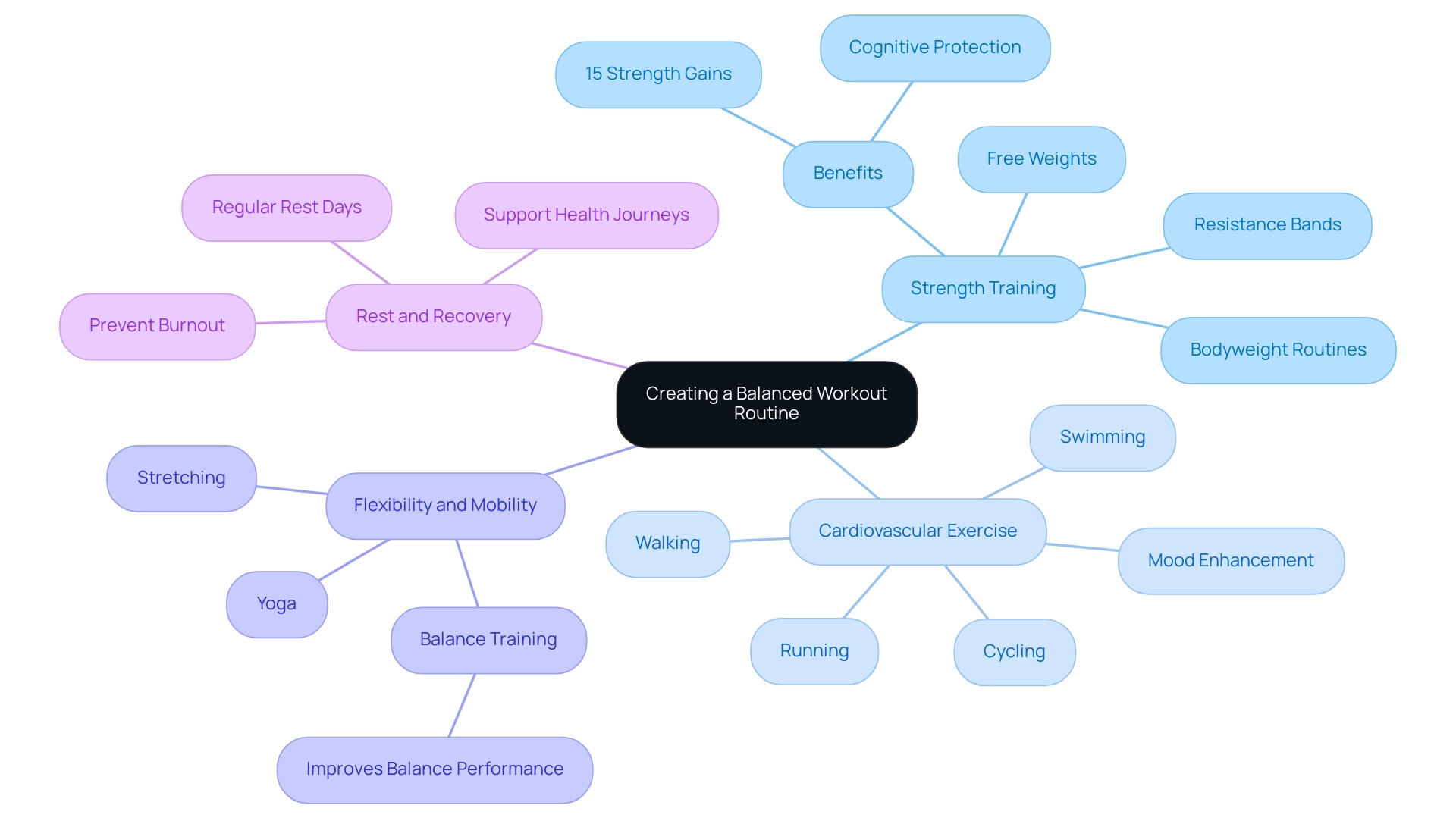
Setting Realistic Fitness Goals
Setting achievable health objectives is a vital milestone on any wellness journey, particularly in a work environment where employee well-being is essential. Here are some empowering strategies to help you set achievable objectives:
-
Be Specific: Rather than adopting vague aspirations like 'get fit,' focus on precise targets such as 'exercise three times a week' or 'increase my squat weight by 10 pounds within two months.'
Specificity transforms wishes into actionable plans, echoing the wisdom of Antoine de Saint-Exupery, who stated,
A goal without a plan is just a wish.
In a workplace context, this could translate to encouraging employees to participate in specific wellness programs or classes, supported by experienced coaches who can provide personalized guidance and help them gain knowledge and skills for a healthier life.
-
Make It Measurable: Goals should be quantifiable, facilitating progress tracking.
Utilize metrics such as weight, repetitions, or duration of workouts to evaluate improvements. This aligns with the growing trend of functional training, which is ranked #14 in the ACSM's 2024 top 20 trends, indicating its relevance and effectiveness in workplace wellness programs.
-
Set Attainable Goals: While it’s essential to stretch your limits, ensure that your objectives are realistic considering your current physical condition and lifestyle.
Establishing unrealistic objectives can lead to frustration and burnout, hindering your journey rather than enhancing it. For HR Benefits Managers, encouraging employees to establish attainable objectives can enhance participation in workplace fitness initiatives, especially when they have access to personalized health coaching that empowers them to thrive.
-
Time-Bound: Establish a clear timeline for your objectives.
This not only creates a sense of urgency but also sharpens your focus. For instance, aiming to complete a 5K in three months adds a tangible target to work toward, which can be a motivating challenge for employees. Engaging with our health coaching app, available for a free 7-day trial, offers the support needed to stay on track and provides resources that guide employees in making lasting lifestyle changes.
-
Celebrate Small Wins: Recognizing and celebrating every achievement, no matter how minor, can significantly boost motivation and engagement.
This practice fosters a positive relationship with exercise, encouraging sustained commitment. A case study on 'Strategies for Maintaining Focus' highlights that regular review and adjustment of goals, along with accountability mechanisms, can effectively combat goal fatigue and distractions, ensuring continued commitment to personal development.
By focusing on setting realistic health goals, particularly in a workplace environment, HR Benefits Managers can help employees pave their way to success while cultivating a deeper connection with their health journey. This, in turn, enhances overall well-being and productivity, allowing them to start their journey towards a better you with the right support and resources.
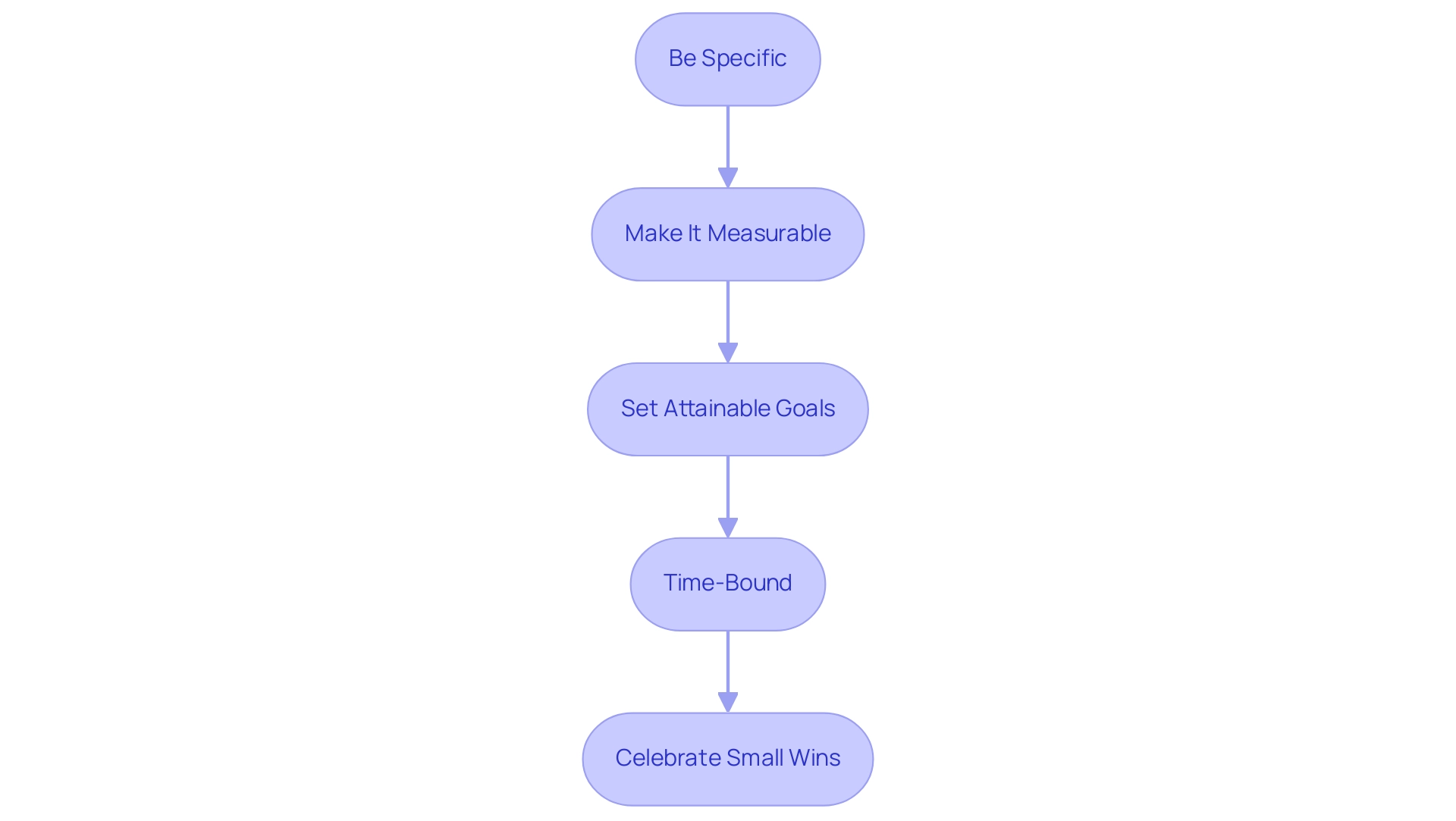
Finding Support and Motivation
Support and motivation are crucial elements that can transform your fitness journey into a successful and enjoyable experience. Here are several effective strategies to cultivate a supportive environment:
-
Exercise Partners: Pairing up with a friend or family member can significantly enhance your training experience.
As Dr. Tanaka observes, training companions offer significant encouragement to stick to fitness objectives. Not only do workout companions make physical activity more enjoyable, but they also help keep you accountable, especially when tackling challenging routines. Additionally, working out with a partner can provide safety during exercises, particularly when using heavy weights, reducing the risk of injury.
-
Join a Class or Group: Immersing yourself in fitness classes or community groups fosters motivation and creates a sense of belonging.
Whether you seek local classes or explore online options, finding a group that aligns with your interests can invigorate your exercise routine while introducing you to like-minded individuals. Research on social dynamics in exercise video games indicates that interpersonal connections can enhance motivation, making group settings particularly beneficial for those who struggle with traditional workout partners.
-
Seek Professional Guidance: If you're uncertain about how to kick-start your wellness journey, consider enlisting the help of a personal trainer.
A trainer can offer personalized guidance and support tailored to your goals, ensuring that you stay motivated as you progress.
-
Engage with Online Communities: Engaging with online wellness communities or social media groups can provide valuable encouragement.
Sharing your journey, celebrating milestones, and receiving tips from others can significantly boost your motivation.
-
Track Your Progress: Utilize exercise apps or journals to monitor your workouts and achievements.
Research indicates that individuals who track their progress tend to maintain higher motivation levels—seeing tangible results can be a powerful incentive to keep pushing forward.
For instance, a study showed that participants had a PACES score of 2.51 ± 0.53 on Day 6, reflecting their adherence and motivation levels.
By surrounding yourself with supportive individuals and resources, you can cultivate an environment that fosters motivation and commitment to your fitness journey. Embracing these strategies not only ensures personal success but also inspires those around you to prioritize their well-being.
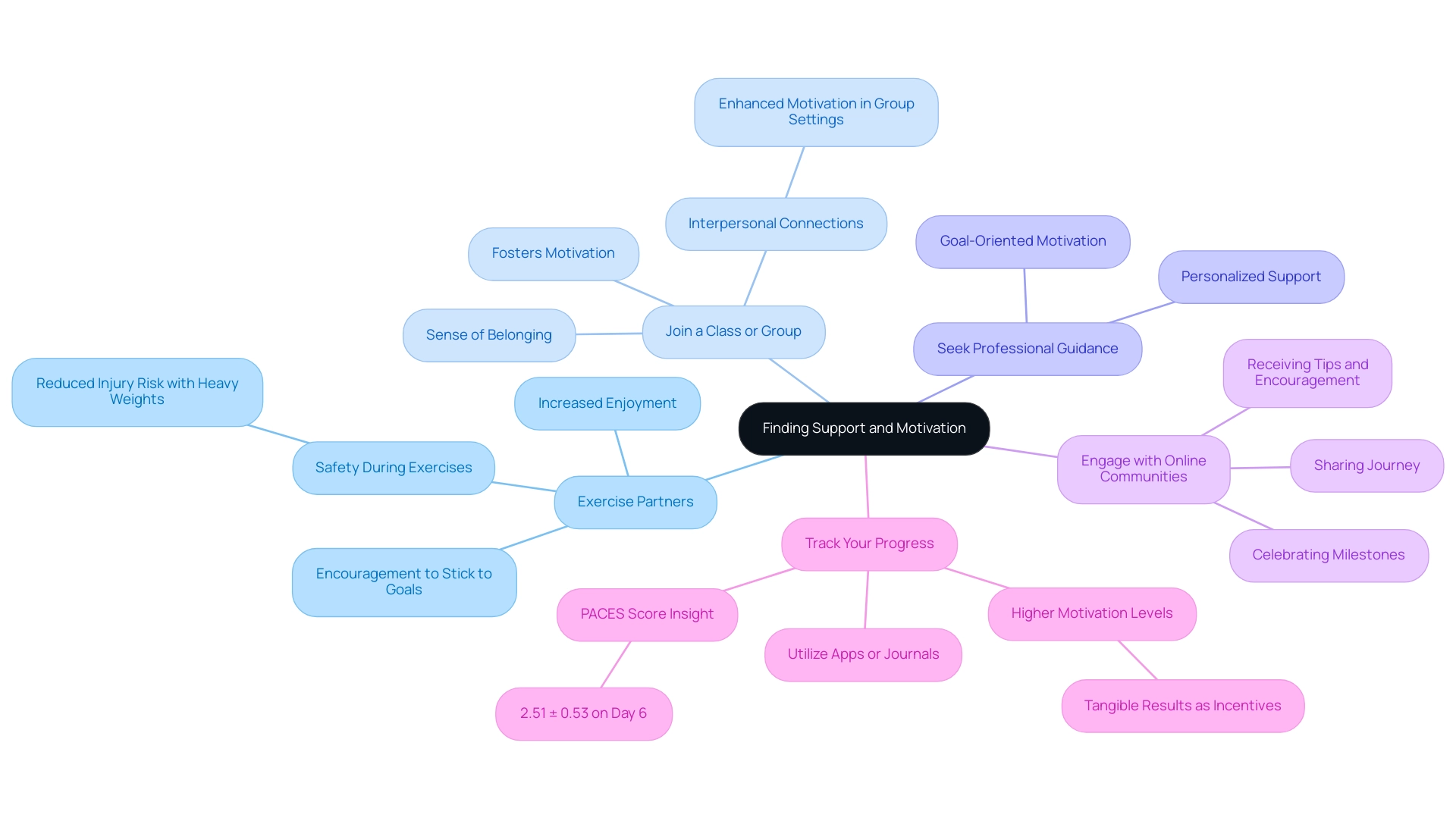
Conclusion
Equipping oneself with the right tools, understanding how to use them safely, and creating a balanced workout routine are fundamental steps in any fitness journey. The essential starter equipment, including dumbbells, resistance bands, and yoga mats, sets the stage for effective workouts, while safety practices ensure that beginners can engage confidently without the risk of injury. Establishing a balanced routine that incorporates:
- Strength training
- Cardiovascular training
- Flexibility training
not only promotes physical health but also enhances mental well-being, particularly within workplace environments.
Setting realistic and measurable fitness goals is another critical aspect that empowers individuals to stay motivated and track their progress. By creating specific, attainable objectives and celebrating small victories along the way, individuals can maintain their commitment to personal growth. Furthermore, finding support through:
- Workout buddies
- Classes
- Online communities
can transform the fitness experience into a more enjoyable and fulfilling journey.
Ultimately, the combination of the right equipment, knowledge of safe practices, a well-rounded routine, and a supportive environment creates a robust foundation for success. By embracing these principles, anyone can unlock their potential and embark on a transformative path toward better health and well-being. Now is the time to take action, prioritize fitness, and inspire those around to do the same, fostering a culture of health that benefits everyone involved.




